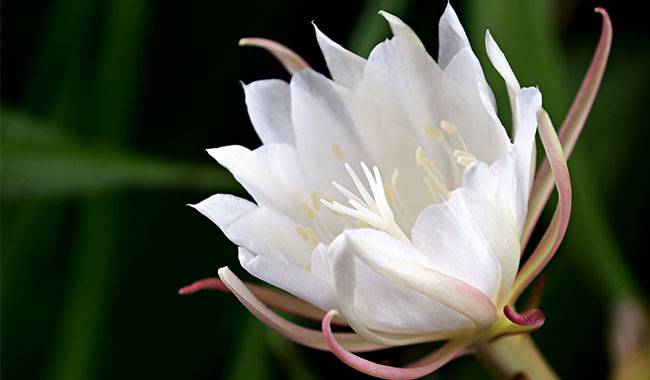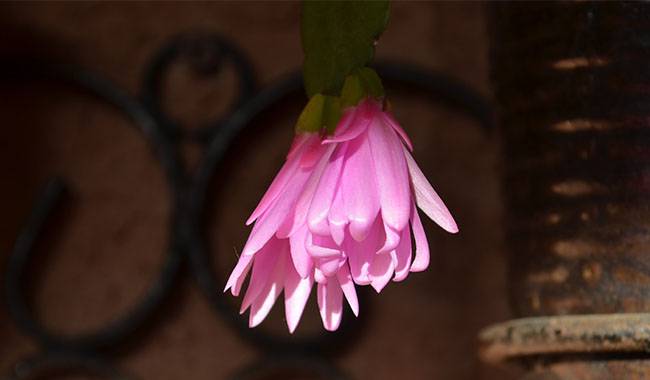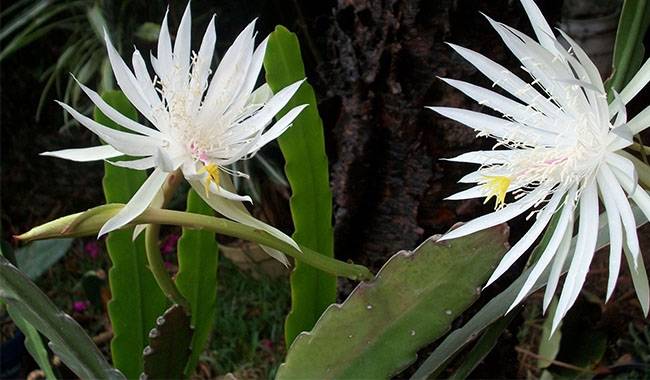
Despite the confusion that has accumulated over the name “Christmas Cactus” in recent decades, the Orchid Cactus remains a global favorite as one of the most recognizable and striking forest cacti. Hybrid Orchid Cactus plants are leafless, with flattened stems and a surprising amount of blooms, and their drooping branches and delicate flowers require little maintenance from their owners. Hardy and long-lived, they can be used in the living room and are the brightest flowering succulents in any collection. You will learn to grow and care Orchid Cactus (Epiphyllum) in the ThumbGarden article.
DESCRIPTION OF ORCHID CACTUS PLANTS
Among houseplants, it is difficult to find a plant with a name that causes as much controversy and confusion as members of the genus Epiphyllum. These cacti sometimes disappear from the shelves, sometimes boring, but they have never really left the greenhouse bloom scene in their history.
The name Orchid Cactus (epiphyllum) was distorted as the name of the cactus was attributed to slumberers, rhipsalidopsis and almost all zygocactus. cacti were excluded from their ranks and then reincorporated again. Even today, Orchid Cactus plants are often mistaken for cataloged water lilies, when in fact this plant is very distinct.
The easiest way to distinguish Orchid Cactus plants from their relatives is to look at their flowering. Any classification of leafless Orchid Cactus plants as leafy cacti is a misconception, albeit a common one.
Epiphyllums get their name from the flattened stems that flower like leaves directly on their respective “leaves”, which in this cactus are often confused with the leaves of other forest Orchid Cactus plants. Folk nicknames call them fiery, leaf-shaped or orchid-like cacti.
In nature, Orchid Cactus plants are widely distributed throughout the earth in tropical climates, where they settle as rather large Orchid Cactus plants on vines and woody plants in moist forests.
Epiphyllums are leafless semi-shrubs with pendulous rather than erect branches. They are one of the best known leafless Orchid Cactus plants and are the hallmark of the entire group of heavily flowering forest cacti. The bases of the skeletal shoots gradually become woody and change in shape from flattened to rounded or triangular.
The height of Epiphyllum varies from 20 inches (0.5 m) to 40 inches (1 m), and the actual size of the plant is determined by the length of its shoots.” Orchid Cactus plants are not ‘small’ or compact. Their huge flowers and long stems look massive, and the plants themselves can stretch out quite a bit.
Orchid Cactus plants have a dormant period that lasts from November to March, when the shoots resume growth. During this period, the cactus will not bloom without the right conditions.
LEAF-SHAPED SHOOTS OF ORCHID CACTUS PLANTS
Epiphyllum stems do not divide as actively, but the skeleton-like old branches produce many new shoots that look like huge stiff leaves. These initially grow upright and remain quite delicate, but gradually bend to resemble linear leaves.
Orchid Cactus does not form dense flower clusters even with aging, but the number of stems increases, as does their growth rate. They are strongly flattened, rarely triangularly flattened, firm but still very fleshy, long, stalked or pendulous. The typical matte blue-medium green color perfectly accentuates the beauty of the flowers and looks very attractive.
The stems, due to their large size and curves, look like leaves, although the filiform, undulating or toothed edges are typical of all Orchid Cactus cacti. Adult plants do not produce prickles.
Epiphyllums do not produce true leaves, although they are still leafless forest cacti. However, they do form aerial roots directly on the stem, something that most Orchid Cactus cacti cannot boast.
ORCHID CACTUS FLOWERING AND FRUITING

Orchid Cactus blooms very profusely, starting in May and ending its procession in late summer. This cactus usually starts flowering from the third year. Orchid Cactus plants that bloom at Christmas are artificially kicked out of a dormant period to correct the timing of flowering. However, the typical Orchid Cactus plant is a summer-flowering plant.
Unlike many beautiful cacti, they stay in the budding stage for a surprisingly long time. Varying in shape, size from 1 inch (2.5 cm) to almost 13 inches (35 cm) and structure, the funnel-shaped Orchid Cactus flowers with their rather long tubes can be simple or terrifying. But they still appear very large and showy.
The pedicels are almost as long as the flowers and have light green bracteoles. epiphyllum has ten slender, pointed, outer perianth lobes that form a perfect circle or are slightly curved backward. The lance-shaped petals with rounded margins are straight and form a funnel-shaped, gradually opening flower.
Although the inner and outer lobes are the same length, even the single-leaved Orchid Cactus has the effect of an outer envelope or outer ring on which the luxurious flowers rest. The beautiful, double-rowed, glowing stamens and the white, long pistils are fully visible in the pharynx.
The flowers of the large Orchid Cactus plants bloom very quickly, lasting only 2-3 days on the plant. However, the large number of buds allows the cactus to flower continuously, and this short, widespread flowering goes almost unnoticed.
Almost all Orchid Cactus plants are quite fragrant and surprising, not only because of their beautiful structure but also because of the intensity of their refreshing sweet smell.
The color range of Orchid Cactus plants includes all the classic “cactus” shades – from the bright, large red color usually associated with Orchid Cactus plants to white, cream, orange, pink, purple, and even lilac varieties. Red Orchid Cactus plants seem to be engulfed in blooming flames, but even Orchid Cactus plants of other colors still have the effect of colored waves, cascades, clouds, or flames.
Unlike the stems, the ovaries and tubes of Orchid Cactus plants are covered with spines and hairs. Fruiting of Orchid Cactus plants can only be achieved by artificial plant pollination. Edible, very beautiful, bright red fruits adorn it as well as the flowers of the cactus.
VARIETIES OF ORCHID CACTUS
Orchid Cactus species are not found in indoor collections today. Although there are nearly 20 species in the genus Epiphyllum, species native to Central and South America are rarely used as cultivated plants.
Species of Orchid Cactus plants that still occur include.
- Epiphyllum oxypetalum (Queen of the Night) is a beautiful species with linear, dark green, flat shoots that grow to 80 inches (2 m) and snow-white, star-shaped flowers that are slightly reminiscent of edelweiss. This Orchid Cactus plant is known for its fragrance.
- Epiphyllum crenatum is a showy, well-branched cactus with shoots up to 40 inches (1 m) tall that form bushy branches of nearly equal diameter. The medium green color of the flat shoots is combined with bright, beautifully serrated edges and abundant flowering to create a cascading effect.
However, most of the plants that can be bought are hybrids obtained by crossing these species with various ceramics. They possess better characteristics, mainly richer and more compact flowering. But the most important thing is not only the ability to bloom at night like their wild relatives but also to display their gorgeous flowers during the day.
Very often, epiphyllum hybrids are labeled synonymously – as Phyllocactus phyllanthoides.
Epiphyllum species can be divided into amplexicaul, hanging, cascading shoots, and clumped, straighter shoots that only become pendulous with age. The latter are divided into high- and low-growing ones, with the “dwarfs” almost replacing their larger counterparts.
Orchid Cactus plants are always selected according to their flowering period – size and flower structure, which varies from species to species. The best Orchid Cactus plant varieties are yellow Reward and George French, deep yellow King Midas, green Nicole, yellow Queen Anne with intricate petals, pink Meadow Rose, purple-pink Wendy, pink to purple variegated Impello, pink Madras Ribbon, orange-purple Pegasus, red Space Rocket, and more.
GROWING CONDITIONS FOR INDOOR ORCHID CACTUS PLANTS
Light-loving but not sun-loving, Orchid Cactus plants would be one of the easiest cacti to grow if not for the need to overwinter in cold temperatures. Lighting and dormant temperatures are crucial for this cactus to bloom.
Lighting and placement
Unlike many plants that are very capricious to strong light during flowering, the Orchid Cactus plant completely proves its woodland status by growing and flowering in any bright place or light semi-zone. It does not tolerate direct sunlight from a south-facing window (and it is best to always avoid midday sun), but there is no need to place Orchid Cactus plants on windowsills alone.
Reducing light and moving the plant further away from the window is not allowed during the flowering period (but light can be increased during the germination period). In winter, it is best to adjust the lighting to maintain the usual conditions.
Temperature control and ventilation
Orchid Cactus remains one of the most heat tolerant cacti when actively growing. They do well at room temperature, but they are not afraid of heat either, as long as they are watered properly.
Orchid Cactus plants should spend their dormant period in the cooler range of 50-59 °F (10-15°C). Abrupt transitions are not desirable; temperatures will gradually decrease in the fall if needed. A cool overwintering period is one of the main conditions for flowering. However, it is difficult to achieve success without reducing watering.
The epiphytes are very fond of fresh air; they will die indoors if they are not regularly ventilated. This cactus prefers to be ventilated as often as the weather permits or moved to an open balcony, terrace, or semi-shady spot in the garden to prevent precipitation.
Orchid Cactus plants that spend the summer in the garden usually bloom more and grow faster than Orchid Cactus plants that stay indoors during the hottest season.
HOW TO CARE FOR ORCHID CACTUS PLANTS AT HOME

This is not a difficult cactus to care for, and surprisingly it likes humidity. It likes to be watered fairly frequently during periods of vigorous growth and will not refuse at least moderate but frequent fertilization. With the right conditions during the dormant period, Orchid Cactus plants will be easy to grow, even for novice growers.
Watering and air humidity
Despite being a cactus, Orchid Cactus grass is very afraid of dry substrates and should be watered so that the substrate is always moderately moist during its active growth period.
Water in small amounts, but often try to let the top 1 inch (2.5 cm) or so of soil in the container dry out. Overwatering increases the risk of overwatering and root rot, and this plant is less tolerant than moderate but more frequent watering.
For Orchid Cactus plants, the transition to a rest period is very infrequent, maintaining stem watering, which is very different from watering during the active growth period and should be a smooth transition. Watering should be reduced after nutrient cessation, gradually decreasing its frequency and volume.
At all times of the year, water carefully, without soaking the stems and drain the trays immediately.
In addition to the usual such treatments, Orchid Cactus plants require regular sanitary measures. Dust should be removed from the surface of its shoots, and non-flowering shoots will not refuse a shower or immersion in water for 2-3 hours.
This cactus tolerates and prefers to be sprayed in summer when the heating system is running and the air is very dry. However, for Orchid Cactus plants, the use of a fine spray nozzle is a must.
Fertilizer and fertilizer ingredients
No matter how vigorously Orchid Cactus blooms, it remains sensitive to over-fertilization. Fertilizer should be applied only during the peak growth period, ending in August, in order to prepare the cactus for winter. Fertilization can be done as often as usual, but needs to be reduced by a factor of 2-3 or less; once a month. For Orchid Cactus plants, fertilization can only be done by liquid methods and only after watering.
Special fertilizers for cacti and succulents are preferred and can be alternated with organic fertilizers in the summer.
Pruning and shaping Orchid Cactus plants
On this forest cactus, pruning is of a hygienic nature only. Damaged, elongated, and non-flowering, dry, and deformed shoots are usually completely removed in spring, stimulating the growth of new flowering branches. In any case, partial pruning of the “foliage” usually leads to its gradual death.
Transplants, containers, and substrates
Orchid Cactus prefers a stable environment and does not tolerate transplanting very well. Do this only when the plant has nowhere to grow, and replace only the top contaminated soil layer annually.
Ironically, this plant is best transplanted not at the usual time, but after flowering: acclimatizing before the dormant period allows for more abundant flowering. However, for Orchid Cactus plants, transplanting in February is also possible.
Unlike many cacti, Orchid Cactus plants prefer soil rich in humus. They prefer to grow in slightly acidic, good quality, well-drained substrates that are slightly coarser than regular succulent substrates, although they are also suitable for Orchid Cactus plants.
The substrate should contain acidified peat, sphagnum peat, cattle-prod, and wood ash in addition to the necessary sand. If the soil is mixed separately, for Orchid Cactus plants, the soil of the leaves, the ground cover, and the soil of the turf are combined in equal proportions.
Epiphyllums need care as these shrubs are not easy to hold. When planting, do not flood the plants so that they are at the same level. Epiphyllums should not be fertilized after transplanting. If they finish after flowering, fertilize only in the spring. In case of unscheduled transplanting, no transplanting should be done within 5-6 weeks after this procedure.
Pests and problems of growing Orchid Cactus
It is not the most resistant of the cacti. Orchid Cactus is often troubled by spider mites, aphids, and scales. In addition, aphids like Orchid Cactus plants in flowers are most threatening when they are brought into the fresh air. To protect plants, you need to combine pest control with biological or conventional insecticides and adjust conditions by increasing humidity and sanitation.
The most common disease on Orchid Cactus plants is rot, but it only occurs when they are kept cool and systematically overwatered. They can only be treated by replanting and removing damaged parts.
Propagation of Orchid Cactus plants
The main method of propagation of Orchid Cactus is still cuttings. This plant is hardly ever grown from seed at home.
Orchid Cactus plugs are cut from strong, young, undamaged shoots. The stems are usually cut into small pieces of about 2 inches (5 cm), charred, and left for 2-3 days until a thick film forms at the cut. Soaking in a growth promoter will speed up the rooting process.
Root cuttings in the sand, preferably coarse or river sand, preheated, under a mulch or cling film to keep soil moisture light and stable. If there is plenty of planting material, rooting can also be done in water by burying the lower cuttings in 0.4-0.6 inches (1-1.5 cm).







